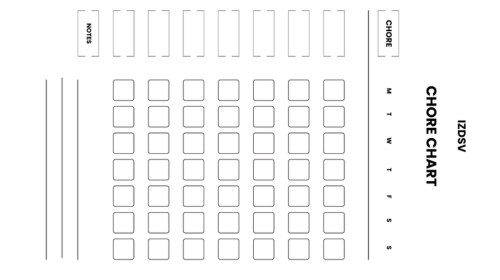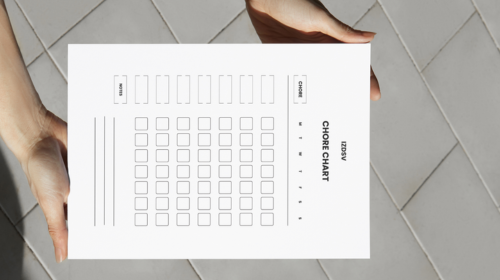Editable Monthly Chore Chart Template
What is a Chore Chart and How Does It Work?
A chore chart is a visual tracking system that assigns specific household tasks to family members and monitors their completion over time. It typically displays tasks, assigned individuals, and completion status through checkmarks, stickers, or other marking systems.
- Provides clear expectations for each family member’s responsibilities
- Creates accountability through visible progress tracking
- Establishes routine and structure for household maintenance
- Can include reward systems or consequences for task completion
- Often organized by daily, weekly, or monthly timeframes
- May incorporate age-appropriate tasks for different family members
Understanding the Basics of a Chore Chart
Chore charts function as organizational tools that break down household responsibilities into manageable, trackable tasks for each family member. The system relies on visual representation and consistent monitoring to encourage participation and completion of assigned duties.
- Uses columns or rows to organize tasks, people, and timeframes
- Incorporates visual elements like checkboxes, stars, or color coding
- Assigns age-appropriate responsibilities based on family members’ capabilities
- Establishes clear deadlines or schedules for task completion
- May include both individual and shared household responsibilities
- Often posted in common areas for easy visibility and access
Benefits of Using a Chore Chart for Families
Chore charts promote shared responsibility and reduce conflicts by clearly defining who does what tasks and when they should be completed. They also teach children valuable life skills while helping parents distribute household workload more evenly among family members.
- Develops responsibility and accountability in children
- Reduces arguments about who should do which tasks
- Creates a fair distribution of household work among family members
- Builds time management and organizational skills
- Provides opportunities for earning allowances or privileges
- Establishes routines that become automatic over time
- Teaches the importance of contributing to family life
- Helps children develop a work ethic and pride in accomplishment
How to Create Your Own Chore Chart Template
Start by listing all necessary household tasks and determining which family members can realistically handle each responsibility based on age and ability. Then choose a format that works for your family, whether it’s a simple paper chart, digital app, or decorative board system.
- Assess your household’s specific cleaning and maintenance needs
- Match tasks to appropriate family members based on age and skill level
- Choose between paper charts, digital apps, or physical board systems
- Design clear columns for names, tasks, days of the week, and completion tracking
- Include both daily tasks and weekly or monthly responsibilities
- Add visual elements like stickers, checkmarks, or color coding
- Establish clear consequences and rewards for completion or non-completion
- Post the chart in a highly visible location where everyone can see it
- Plan regular family meetings to review progress and make adjustments
- Keep the system simple enough that everyone can use it consistently
How Can I Customize an Editable Chore Chart?
Customizing an editable chore chart involves selecting a template that matches your family’s size and needs, then modifying elements like names, tasks, colors, and layout to fit your specific household. Most digital platforms offer drag-and-drop functionality and pre-designed elements that make personalization straightforward without requiring design experience.
- Choose templates with the right number of family members and task categories
- Modify colors and fonts to match your family’s preferences or home decor
- Add or remove task categories based on your household’s specific needs
- Include family members’ names and photos for better visual recognition
- Adjust the time frame from daily to weekly or monthly tracking
- Incorporate reward systems like point values or sticker collections
- Add motivational graphics, icons, or themes that appeal to your children
- Include space for notes, comments, or special instructions
Steps to Edit Your Chore Chart Template
Begin by selecting a base template that closely matches your family structure and household needs, then systematically modify each section to reflect your specific requirements. Save multiple versions as you make changes so you can easily revert to previous iterations if needed.
- Download or access your chosen editable template in the appropriate software
- Replace placeholder names with actual family member names
- Substitute generic tasks with your household’s specific chores and responsibilities
- Adjust task frequency and scheduling to match your family’s routine
- Modify colors, fonts, and design elements to create visual appeal
- Add or remove rows and columns based on your family size and task variety
- Include age-appropriate tasks and adjust difficulty levels accordingly
- Test print or display the chart to ensure readability and functionality
- Save the final version and create backup copies for future use
Using Canva for Customizable Chore Charts
Canva provides user-friendly design tools with hundreds of chore chart templates that can be easily customized without graphic design skills. The platform offers both free and premium elements, allowing you to create professional-looking charts with drag-and-drop functionality and real-time collaboration features.
- Browse Canva’s extensive library of chore chart templates by searching “chore chart”
- Select templates based on family size, age groups, or design preferences
- Use the drag-and-drop editor to replace text, images, and design elements
- Access thousands of free icons, illustrations, and graphics to enhance your chart
- Customize colors using Canva’s color palette tools or brand kit features
- Add personal photos of family members or household areas for a better connection
- Utilize Canva’s text editing tools to change fonts, sizes, and formatting
- Share editing access with family members for collaborative input
- Download in various formats, including PDF, PNG, or keep as an editable Canva file
- Create multiple versions for different seasons or changing household needs
Tips for Tailoring the Chart to Your Family’s Needs
Consider your family’s unique dynamics, schedules, and motivational factors when customizing your chore chart to ensure maximum engagement and success. Pay attention to each family member’s personality, preferences, and developmental stage to create a system that works for everyone involved.
- Assess each family member’s current skill level and gradually increase task difficulty
- Consider work and school schedules when assigning time-sensitive chores
- Include both individual tasks and collaborative family projects
- Balance fun, easy tasks with more challenging or less enjoyable ones
- Incorporate your children’s interests through themed designs or task names
- Allow flexibility for special circumstances, holidays, or schedule changes
- Include non-chore activities like homework completion or acts of kindness
- Create different reward systems that motivate each family member effectively
- Plan regular review sessions to gather feedback and make necessary adjustments
- Consider seasonal variations in tasks like yard work or holiday preparations
- Include emergency or backup plans for when family members are sick or unavailable
- Make the chart accessible to all family members, including those with special needs
How Do I Implement a Monthly Chore Schedule?
Implementing a monthly chore schedule requires breaking down household tasks into weekly segments while accounting for seasonal needs and family commitments throughout the month. This approach allows for better planning of deep-cleaning projects and rotating responsibilities while maintaining daily maintenance tasks.
- Start by listing all monthly household tasks, including deep cleaning and seasonal maintenance
- Divide tasks into four weekly segments to distribute the workload evenly
- Schedule lighter weeks during busy family periods like holidays or school events
- Include both recurring daily tasks and monthly deep-cleaning projects
- Plan for seasonal variations such as yard work, holiday decorating, or spring cleaning
- Build in buffer time for unexpected events or illness that might disrupt the schedule
- Coordinate with family calendars to avoid conflicts with work, school, or activities
- Establish specific dates for rotating tasks like cleaning out closets or organizing storage areas
Creating a Monthly Routine with Your Chore Chart
A successful monthly routine balances consistency with flexibility by establishing regular patterns while allowing for seasonal adjustments and special circumstances. The key is creating sustainable habits that family members can follow without feeling overwhelmed by the scope of monthly responsibilities.
- Design weekly themes such as “Kitchen Deep Clean Week” or “Outdoor Maintenance Week”
- Establish consistent daily tasks that remain constant throughout the month
- Schedule monthly family cleaning days for larger projects requiring multiple people
- Create visual calendars showing which tasks occur during specific weeks
- Plan monthly review meetings to assess what’s working and what needs adjustment
- Include preparation time for upcoming seasons or special events
- Designate specific days for rotating or less frequent tasks, like window cleaning
- Build in rest periods between intensive cleaning weeks
- Coordinate monthly schedules with family vacation or travel plans
- Include monthly organizing sessions for different areas of the home
Assigning Chores for Each Family Member
Monthly chore assignments should consider each person’s capabilities, schedules, and natural preferences while ensuring fair distribution of both enjoyable and less desirable tasks. Rotate responsibilities monthly to prevent anyone from being stuck with the same unpleasant tasks indefinitely.
- Match complex monthly tasks to family members with appropriate skill levels
- Rotate assignments monthly so everyone experiences different types of work
- Consider each person’s natural strengths and interests when making assignments
- Balance time-intensive tasks with quicker daily maintenance responsibilities
- Account for family members’ work and school schedules when assigning weekend tasks
- Pair experienced family members with beginners for teaching opportunities
- Include individual accountability for personal spaces alongside shared areas
- Create backup assignments for when the primary responsible parties are unavailable
- Establish clear expectations and deadlines for monthly project completion
- Allow family members to trade assignments when schedules conflict
- Include age-appropriate monthly goals that challenge but don’t overwhelm children
Tracking Progress and Adjusting the Schedule
Effective monthly tracking requires systems that capture both daily consistency and monthly project completion while remaining simple enough for busy families to maintain. Regular assessment and adjustment ensure the schedule remains realistic and beneficial for all family members.
- Use weekly check-ins to monitor daily task completion and monthly chore chart project progress
- Create visual progress indicators like percentage bars or completion calendars
- Implement monthly family meetings to discuss what’s working and what isn’t
- Track completion rates to identify tasks that consistently get skipped or delayed
- Adjust task assignments based on changing family circumstances and capabilities
- Document seasonal patterns to improve future monthly planning
- Celebrate monthly achievements and completed projects with family rewards
- Identify and address obstacles that prevent consistent task completion
- Modify the schedule when certain weeks prove consistently too busy or overwhelming
- Keep records of successful monthly schedules to replicate effective patterns
- Include family feedback in schedule adjustments to maintain buy-in and motivation
- Plan for gradual increases in responsibility as children develop new skills
What Are the Best Practices for Using a Chore Chart?
Successful chore chart implementation requires consistent enforcement, clear expectations, and regular family communication to maintain momentum and effectiveness. The most effective charts balance structure with flexibility, allowing families to adapt the system as needs change while maintaining core routines that build lasting habits.
- Establish clear, specific expectations for each task rather than vague instructions
- Maintain consistency in checking and updating the chart daily
- Provide immediate feedback and recognition for completed tasks
- Start with fewer tasks and gradually increase responsibilities as habits form
- Make the chart visible and accessible to all family members
- Include both individual accountability and family teamwork elements
- Plan regular family meetings to discuss progress and make adjustments
- Balance consequences for incomplete tasks with rewards for consistent completion
- Keep instructions simple and age-appropriate for the youngest participants
- Build flexibility into the system for illness, special events, or changing schedules
Involving Kids in Chore Assignments
Children develop stronger ownership and commitment when they participate in creating their chore assignments rather than simply receiving predetermined tasks. This collaborative approach helps kids understand the reasoning behind household responsibilities while building problem-solving and negotiation skills.
- Hold family meetings where children can voice preferences and concerns about tasks
- Allow kids to choose between several age-appropriate options rather than assigning everything
- Explain the purpose and importance of each household task to build understanding
- Let children suggest improvements or modifications to make tasks more efficient
- Include kids in determining fair consequences and rewards for the chore system
- Encourage children to identify household needs and propose solutions
- Create opportunities for siblings to work together on collaborative projects
- Allow older children to mentor younger ones in completing more complex tasks
- Include children in evaluating whether the current system is working effectively
- Let kids rotate through different types of tasks to discover their preferences and strengths
- Provide opportunities for children to earn additional privileges through extra responsibilities
Setting Up a Weekly and Daily Routine
Effective routines create predictable patterns that reduce decision fatigue while ensuring essential tasks get completed consistently. The key is establishing rhythms that work with your family’s natural schedule rather than fighting against existing patterns and commitments.
- Designate specific times of day for chore completion, such as before breakfast or after dinner
- Create morning and evening routines that incorporate essential daily tasks
- Establish weekly patterns like “laundry Mondays” or “cleaning Saturdays”
- Build routines around existing family anchors like meal times or bedtime
- Include buffer time for tasks that might take longer than expected
- Plan easier tasks for busy weekdays and more intensive work for weekends
- Create visual cues and reminders that prompt routine behaviors
- Establish family cleanup times when everyone works on tasks simultaneously
- Include both individual responsibilities and whole-family activities
- Design routines that can continue even when parents aren’t home to supervise
- Build in regular breaks and rewards to maintain motivation throughout the week
Using Checklists to Stay on Track
Checklists transform abstract expectations into concrete, actionable steps that family members can follow independently. Well-designed checklists reduce confusion, increase completion rates, and provide clear evidence of progress that motivates continued participation.
- Break complex tasks into smaller, specific steps that anyone can follow
- Include quality standards and completion criteria for each task
- Create separate checklists for different age groups with appropriate detail levels
- Use visual elements like checkboxes, pictures, or icons to enhance clarity
- Post checklists in relevant locations like the laundry room or kitchen
- Include estimated time requirements to help family members plan their schedules
- Design portable checklists that can move with family members as they work
- Create master checklists for parents to track overall family progress
- Include space for notes about obstacles encountered or improvements needed
- Use digital checklists that can send reminders and track completion automatically
- Regularly update checklists based on family feedback and changing needs
- Include emergency or backup procedures for when primary systems aren’t working
How Can Chore Charts Teach Kids Responsibility?
Chore charts create a structured environment where children learn to follow through on commitments and understand that their actions directly impact family life. This visual accountability system helps kids develop internal motivation and self-discipline by connecting their efforts to tangible outcomes and family appreciation.
- Establish clear expectations that children must meet independently without constant reminding
- Create natural consequences when tasks aren’t completed, allowing kids to experience responsibility
- Build gradually increasing levels of independence as children demonstrate reliable task completion
- Connect household contributions to family membership and shared living benefits
- Provide opportunities for children to problem-solve obstacles and time management challenges
- Demonstrate how individual actions affect the entire family’s comfort and well-being
- Allow children to experience both success and failure in managing their commitments
- Create situations where kids must prioritize tasks and manage competing demands
- Encourage self-monitoring and honest self-assessment of work quality and completion
- Build trust by giving children important responsibilities that the family depends on
Encouraging Kids to Do Chores Regularly
Consistent encouragement requires balancing support with independence, helping children develop internal motivation rather than relying solely on external pressure. The most effective approach combines positive reinforcement with natural consequences while gradually reducing parental involvement as habits strengthen.
- Start with simple, achievable tasks that build confidence and early success experiences
- Provide specific, descriptive praise that acknowledges effort and improvement over time
- Create predictable routines that make chore completion feel automatic rather than optional
- Use gentle reminders initially, then gradually reduce prompting as habits develop
- Connect chores to privileges and family activities that children value
- Model enthusiasm and pride in maintaining your own household responsibilities
- Avoid taking over tasks when children struggle; instead, offer guidance and patience
- Celebrate consistency and improvement rather than focusing only on perfect completion
- Create accountability partnerships between siblings or family members
- Establish family traditions that recognize and appreciate everyone’s contributions
- Address obstacles and challenges with problem-solving conversations rather than criticism
Benefits of Teaching Kids Through a Chore Tracker
Chore trackers provide concrete evidence of growth and achievement while teaching children valuable life skills like planning, time management, and quality control. These systems help kids understand the connection between consistent effort and positive outcomes in ways that abstract lectures cannot achieve.
- Develops organizational skills as children learn to manage multiple responsibilities and deadlines
- Builds work ethic through consistent practice, completing tasks regardless of mood or preference
- Teaches time management as kids learn to fit chores into their daily schedules
- Creates understanding of cause and effect through the natural consequences of completed or missed tasks
- Develops problem-solving abilities when children encounter obstacles or time conflicts
- Builds self-confidence through visible evidence of capability and contribution to family life
- Teaches quality standards and attention to detail through specific task requirements
- Develops financial literacy when chores connect to allowance or earning opportunities
- Creates understanding of teamwork and interdependence within family systems
- Builds habits of self-evaluation and honest assessment of personal performance
- Prepares children for future independence by practicing essential life skills
Making Chores Fun: Engaging Kids with Rewards
Effective reward systems balance external motivation with intrinsic satisfaction, gradually shifting emphasis from earning prizes to experiencing pride in contribution and accomplishment. The key is creating engaging experiences that make children want to participate while building genuine appreciation for household maintenance.
- Create themed challenges like “speed cleaning competitions” or “chore bingo games”
- Use immediate small rewards like stickers or points that accumulate toward larger prizes
- Design family rewards where everyone benefits from collective chore completion success
- Incorporate music, timers, or games that make routine tasks feel more enjoyable
- Allow children to choose their own rewards from predetermined options or categories
- Create surprise rewards occasionally to maintain excitement and unpredictability
- Use privilege-based rewards like extra screen time or special outings rather than just material items
- Celebrate milestones and achievements with family recognition ceremonies or special meals
- Allow children to earn money for extra chores beyond their basic responsibilities
- Create visual progress tracking with charts, graphs, or completion certificates
- Include non-material rewards like choosing family movie night selections or planning weekend activities
- Design seasonal or holiday-themed reward systems that maintain novelty and engagement




